Problem Set 9: Ch4: 31
| 44 |
56 | Ch8: 30 | 31 | Ch9: 1
|
4 | 5 | 6 | 10
| 11 | 12 | 13 | 16
| 17 | 20 | 22 | 25
| 26 | 27 | 31 | Go up
- by Chris Murray, Julia Scanlon, and Brad Hamlin Fall 2002
Chapter 4:
31. A 6500-kg helicopter accelerates upward at 0.60 m/s²
while lifting a 1200-kg car. (a) What is the lift force exerted by
the air on the rotors? (b) What is the tension in the cable (ignore
its mass) that connects the car to the helicopter?
a)
The total mass that is accelerating at .60 m/s/s is the helicopter mass (6500
kg) and the car's mass of 1200 kg or 7700 kg.
The total weight would be: (7700 kg)(9.80 N/kg) = 75460 N down (-) and an
unknown force by the air on the rotors (F) with an upward (+) acceleration of
.60 m/s/s. F = ma looks like:
<F - 75460 N> = (7700 kg)(.60 m/s/s), F = 80080 N upwards = 8.0
x 104 N up
b)
The tension in the cable is affected by the car's mass, so looking at the 1200
kg car we have this situation:
The total weight would be: (1200 kg)(9.80 N/kg) = 11760 N down (-) the tension
in the cable upward (T) with an upward (+) acceleration of .60 m/s/s. F
= ma looks like:
<T - 11760 N> = (1200 kg)(.60 m/s/s), F = 12480 N upwards = 1.2
x 104 N up
(Table of contents)
44. A box is given a push so that it slides across
the floor. How far will it go, given that the coefficient of kinetic
friction is 0.20 and the push imparts an initial speed of 4.0 m/s?
As it slides across the level floor, the only force acting
on it horizontally is the force of friction:
Ffr
= mkFn
Now, the normal force is just the weight of the box since this floor is level,
which is F = ma, FN = mg, where g is the acceleration of gravity.
The force of friction is then
Ffr
= mkFn
= mk(mg)=
(.20)m(9.8 m/s/s)
Since this is the only force horizontally, the horizontal acceleration is:
F = ma
F = (.20)m(9.8 m/s/s)
So
ma = (.20)m(9.80 m/s/s)
a = (.20)(9.80 m/s/s) = 1.96 m/s/s
Now we have a cute chapter 1 problem to solve:
s = ?, u = 4.0 m/s, v = 0, a = -1.96 m/s/s, t = ?
So find s, use
v2 = u2
+ 2as
s = 4.08 m = 4.1 m
(Table of contents)
56.An 18.0-kg box is released on a 37.0o
incline and accelerates down the incline at 0.270m/s2. Find the
friction force impeding its motion. How large is the coefficient of
friction?
The weight of the
box is (18
kg)(9.80 N/kg) =
176.4 N
The component of the weight parallel to the plane is
(176.4 N)sin(37.0o)
= 106.16 N
The component of the weight perpendicular to the plane is
(176.4 N)cos(37.0o)
= 140.88 N
So now our expression of Newton's second law has the parallel component
of gravity of 106.16 N down (-) the plane, and assuming it is moving down the
plane as well as accelerating down the plane, the force of friction F is
acting up (+) the plane, and the acceleration is .270 m/s/s down (-) the
plane, so:
<F - 106.16 N> = (18.0 kg)(-.270 m/s/s)
F = 101.3 N = 101 N, and the coefficient of friction is given by
Ffr
= mkFn
The Normal force in this case is the perpendicular component of gravity
140.88 N, so we have:
Ffr
= mkFn
101.3 N =
mk(140.88
N)
So mk
= .719
(Table of contents)
Chapter 8:
30. A person exerts a force of 45N on the end of a door
84cm wide. What is the magnitude of the torque if the force is exerted (a)
perpendicular to the door, and (b) at a 600 angle to the face of the
door?
The formula for torque is:
t
= r x F = rFsinq
So for the 60o angle:
t
= (.84 m)(45 N)sin(60o)
= 32.7 Nm = 33 Nm
If the force is applied at a 90o angle to the radius, the factor sinq
becomes 1, and really the torque is:
t
= rF = (.84 m)(45 N) = 37.8 Nm = 38 Nm
(Table of contents)
31. Calculate the net torque about the axle of the wheel
shown below. Assume that a friction torque of 0.40 m N opposes the motion.
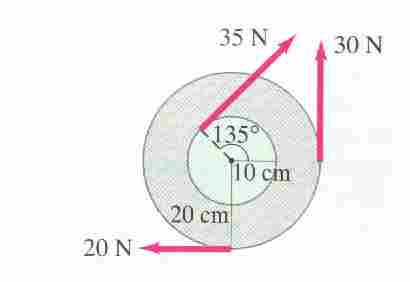
Here we are simply going to add the torques, making CW
torques positive, and ACW (Anti Clockwise - it's an IB term) torques
negative. All angels are 90o so it makes it pretty
easy: (The 135o angle indicated is not relevant:)
t35 = rF
= (.10 m)(35 N) = +3.5 Nm CW
t30 =
-rF = -(.20 m)(30 N) = -6.0 Nm (ACW)
t20 =
rF = (.20 m)(20 N) = +4 Nm CW
Adding all these together:
t =
+1.5 Nm CW
But there is a .4 Nm torque opposing the motion, so assuming that the object
is rotating CW, then the .40 Nm torque would be acting ACW, and the net torque
would be:
t =
+1.5 Nm - .40 Nm = 1.1 Nm CW
(Table of contents)
Chapter 9
1. Three forces are applied to a tree sapling, as
shown in Fig. 9-47, to stabilize it. If F1=282N and F2=355N,
find F3 in magnitude and direction.
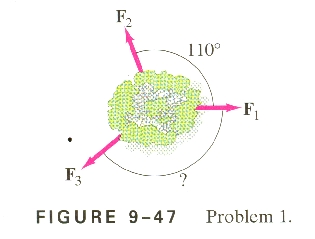
Well, the first thing to do is but F1 and F2
in to components:
F1 is entirely in the +x direction, so it is 282 N x + 0 N y
F2 is a whole 'nother ball of wax. yarn. whatever.
It is (since they give the trigonometric angle)
F2 = (355 N)cos(110o) x + (355 N)sin(110o)
y = -121.42 N x + 333.59 N y
Note that the minus sign not only makes sense for the x component, as it would
be to the left, but, it just comes from the cosine in this case.
So in the x direction, F3 has a component F3x such that:
282 N - 121.42 N + F3x = 0 (i.e
there is no net force as there is no acceleration in the x direction)
And F3x = -160.58 N
And, in the y direction, F3 has a component F3y such
that:
0 N + 333.59 N + F3y = 0 (There is no acceleration in the y
direction)
So F3y = -333.59 N
Now we know that the force F3 has these components:
F3 = -160.58 N x + -333.59 N y
Finally, let's make it into an angle magnitude vector:
Find the magnitude:
hyp = Ö{(160.58
N)2 + (333.59 N)2} = 370 N
The angle between the x axis and the vector is the inverse tangent
of opposite over adjacent:
q
=Tan-1{333.59/160.58} =
64.3o Below the x axis, and to the left of the y, which means the
indicated angle would be 180o - 64.3o = 115.7o
= 116o
(Table of contents)
4.How far out on a diving board (Fig. 9-48) would a 60-kg
diver have to exert a torque of 1000 mN on the board, relative to the left
support post?
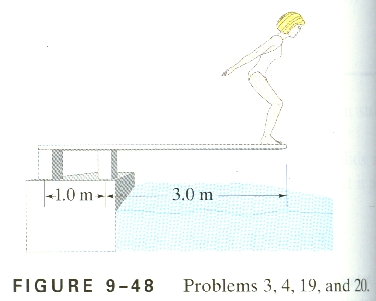
The formula for torque is
t = Fr sinq.
We know that the force exerted by the diver downwards is their weight, F = ma,
F = (60 kg)(9.8 N/kg) = 588 N. The angle here is 90o, since
we assume that the diving board is level, so we can ignore the sine of the
angle, so our expression becomes:
t = Fr
1000-mN = (588 N)r, r = 1.7 m, so she would be .7 m
beyond the rightmost post.
(Table of contents)
5. Two cords support a chandelier in the manner shown in
Fig. 9-6 except that the upper wire makes an angle of 45o with the
ceiling. If the cords can sustain a force of 1300N without breaking, what
is the maximum chandelier weight that can be supported?
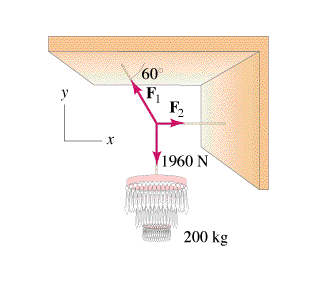
So, pretend the upper angle is 45o. Got it???
We know that the chandelier is not necessarily 200 kg either, but some mass
such that the maximum tension in the cords is 1300 N. Let's just set up
some equations to see which cord is under the most tension, and then, we'll
set that tension to 1300 N>
If we look at the point where the cords come together, you can express the
equilibrium of that point as follows: (The vector sum of F1,
F2, and F3 - where is the weight of the
chandelier)
In the x direction:
F1x + F2x + F3x = 0
-F1cos(45o)+ F2x + 0 = 0
So we know that F2x = F2
(It has no y component) =
F1cos(45o)
In the y direction
F1y + F2y + F3y = 0
F1sin(45o)+ 0 - weight = 0
So we know that
F1 = (weight)/sin(45o)
And
F2 =
F1cos(45o) = ((weight)/sin(45o))cos(45o)
= weight (since sin(45o) = cos(45o))
So F1 is always going to be larger than F2 and F3
which are both equal to the weight, since sin(45o) is less
than one,
and F1 = (weight)/sin(45o)
Now let's solve the problem, making F1 just equal to 1300 N, as
this would be the maximum it could be:
In the x direction:
F1x + F2x + F3x = 0
-(1300 N)cos(45o)+ F2x + 0 = 0
-919.24 N + F2x + 0 = 0
So F2x = 919.24 N
In the y direction
F1y + F2y + F3y = 0
(1300 N)sin(45o)+ 0 - weight = 0
919.24 - weight = 0
So the weight is 919.24 N = 920 N
(Table of contents)
6. Calculate the mass m needed in order to suspend
the leg shown in Fig. 9-49. Assume the leg (with cast) has a mass of
15.0kg, and its CG is 35.0 cm from the hip joint; the sling is 80.5 cm from the hip
joint.
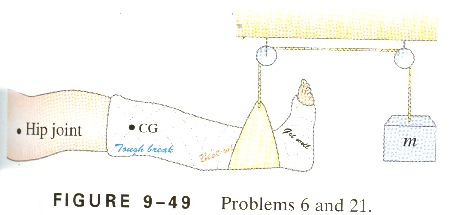
This looks like it will be solvable with torque equilibrium:
If we look at the torques about the hip joint, starting left to right, we have
a clockwise (+) torque due to the weight of the leg (= mg = (15.0 kg)(9.8
N/kg) = 147 N) acting at the center of gravity (CG) .350 m from the hip joint
of
t = Frsinq
= (147 N)(.350 M) = 51.45 Nm, and another counterclockwise (-) torque acting
at the sling location .805 m from the hip joint of t = Frsinq
= (m)(9.8 N/kg)(.805 m) = (7.889Nm/kg)m. Our torque equilibrium looks
like:
<+51.45 Nm - (7.889Nm/kg)m> = 0
so m = 6.52 kg
(Table of contents)
10.A 70-kg adult sits at one end of a 10-m board, on the
other end of which sits his 30-kg child. Where should the pivot be placed so the
board (ignore its mass) is balanced?
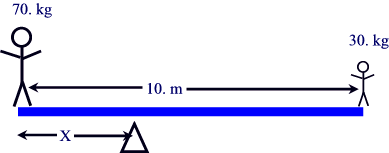
This looks like it is solvable with torque equilibrium:
If we look at the torques about the fulcrum, which is distance x from the
adult, the adult is exerting a force of mg = (70. kg)(9.8 N/kg) = 686 N at
distance x from the fulcrum, causing an anticlockwise (-) torque of
t = Frsinq
= (686 N)x. The child is exerting a force of mg = (30. kg)(9.8 N/kg) =
294 N at distance (10 m - x) from the fulcrum, causing an clockwise (+) torque
of
t = Frsinq
= (294 N)(10 m - x). Our torque equilibrium equation looks like:
<(294 N)(10 m - x) - (686 N)x> = 0
2940 Nm - (294 N)x - (686 N)x = 0
2940 Nm = (980 N)x
x = 3.0 m
(Table of contents)
11. Repeat problem 10 taking into account the board's
15-kg mass.
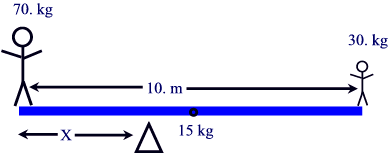
This looks like it is also solvable with torque equilibrium:
If we look at the torques about the fulcrum, which is distance x from the
adult, the adult is exerting a force of mg = (70. kg)(9.8 N/kg) = 686 N at
distance x from the fulcrum, causing an anticlockwise (-) torque of
t = Frsinq
= (686 N)x. The child is exerting a force of mg = (30. kg)(9.8 N/kg) =
294 N at distance (10 m - x) from the fulcrum, causing an clockwise (+) torque
of
t = Frsinq
= (294 N)(10 m - x). Finally we have the board itself whose weight of
(15 kg)(9.8 N/kg) = 147 N is acting at the center of the seesaw, or at a
distance of (5.0 m - x) from the fulcrum, and creating a clockwise (+) torque
of
t = Frsinq
= (147 N)(5.0 m - x). Our torque equilibrium equation looks like:
<(294 N)(10 m - x) + (147 N)(5.0 m - x) - (686 N)x> = 0
2940 Nm - (294 N)x + 735 Nm - (147 N)x - (686 N)x = 0
2940 Nm + 735 Nm = (294 N)x + (147 N)x + (686 N)x = (1127 N)x
x = 3.26 m from the adult
(Table of contents)
12. Find the tension in the two cords shown in Fig.
9-51. Neglect the mass of the cords, and assume that the angle is 30o
and the mass m is 200kg
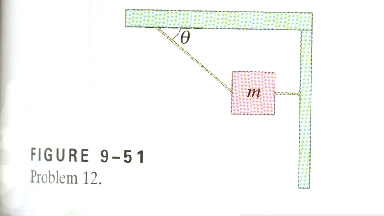
If we ignore any tendency of the box to rotate. (can we?)
this is just a force equilibrium problem.
In the horizontal direction, we have a component of the tension of the cord on
the left (TL) of TLcos(30o) acting to the
left (-), and the entire tension of the rightmost cord (TR) acting
to right (+). Our horizontal equilibrium looks like:
TR - TLcos(30o) = 0
Vertically, the cord on the left has a vertical component TLsin(30o)
acting up (+) and the weight of the mass is (200 kg)(9.8 N/kg) = 1960 N down
(-):
TLsin(30o) - 1960 N = 0. This is directly solvable
for TL:
TL = (1960 N)/sin(30o) = 3920 N, And now with the first
equation we can solve for the right cord:
TR - TLcos(30o) = 0
TR = (3920 N)cos(30o)
TR = 3394.819583 = 3400 N
(Table of contents)
13. Find the tension in the two wires supporting the
traffic light shown in Fig. 9-52.
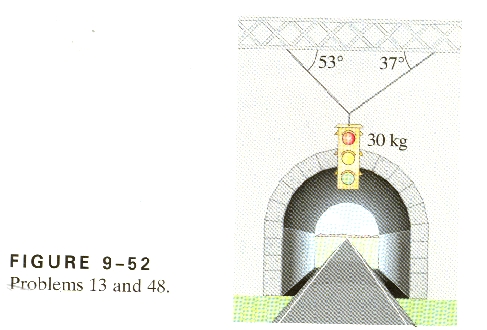
This is a force problem. So let's go:
Vertical:
We have the weight of the light (30 kg)(9.8 N/kg) = 294 N down (-), and the
vertical components of the tensions in the cords. I will call the
leftmost cord TL and the rightmost TR. The vertical
component of TL is TLsin(53o), and of TR,
TRsin(37o) and these are both upward (+) so our
equilibrium looks like:
TLsin(53o) + TRsin(37o) -
294 N= 0
Which is not solvable, as it has two unknowns. So let's set up
Horizontal.
In the x direction, we have the horizontal components of the two cords acting
in the opposite directions. The horizontal component of TL, TLcos(53o),
acts to the left (-), and the horizontal component of TR, TRcos(37o)
acts to the right (+) so we have
TRcos(37o) - TLcos(53o) = 0
Which means that
TR = TLcos(53o)/cos(37o)
Popping this into our first equation, we get:
TLsin(53o) + TRsin(37o) - 294 N= 0
TLsin(53o) +
{TLcos(53o)/cos(37o)}sin(37o)
- 294 = 0
So
TLsin(53o) +
TLcos(53o)tan(37o) =
294 N
TL(sin(53o)
+
cos(53o)tan(37o))
= 294 N
TL = (294 N)/(sin(53o)
+
cos(53o)tan(37o))
= 234.79884 N = 230 N (the book says 240??)
And since
TR = TLcos(53o)/cos(37o)
TR = (234.79884 N)cos(53o)/cos(37o)
= 176.9336 N = 180 N
But wait - there is a better way to do this.
Since 37o and 53o are complementary,
we can just set up our coordinate system along the cables....
(Table of contents)
16.A 0.60kg sheet hangs from a massless clothesline as
shown in Fig. 9-53. The line on either side of the sheet makes an angle of
3.5o with the horizontal. Calculate the tension in the
clothesline on either side of the sheet. Why is the tension so much
greater than the weight of the sheet?
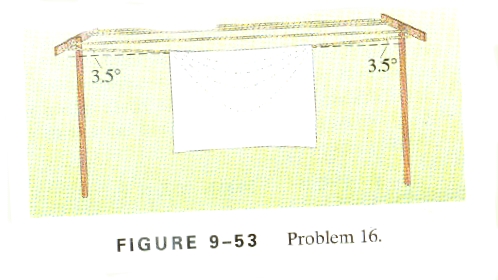
The tension in the clothesline has two vertical components
of Tsin(3.5o) that act upward (+) against the force of gravity (.60
kg)(9.8 N/kg) = 5.88 N acting on the sheet downward (-) so our vertical
equation of equilibrium is:
Tsin(3.5o) + Tsin(3.5o) - 5.88 N = 0
2Tsin(3.5o) - 5.88 N = 0
T = (5.88 N)/(2sin(3.5o))
= 48 N
Since only the vertical components balance the weight, and since the angle is
so small, then it takes a great deal of tension so that 2Tsin(3.5o)
= 5.88 N
(Table of contents)
17. A door, 2.30m high and 1.30m wide, has a mass of
13.0kg. A hinge 0.40m from the top and another hinge 0.40m from the bottom
each support half the door's weight (Fig. 9-54). Assume that the center of
gravity is at the geometrical center of the door, and determine the horizontal
and vertical force components exerted by each hinge on the door.
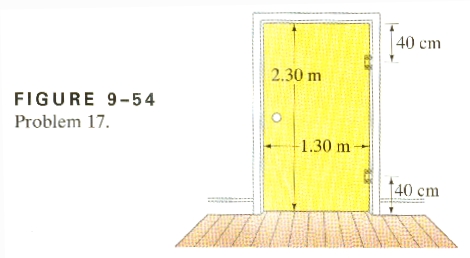
Let's call the force exerted by the upper hinge Upper, and
the force exerted by the lower hinge Lower. For force equilibrium, we
know that the horizontal components that the hinges exert must cancel out, as
they are the only players acting horizontally. Let's guess that the
upper hinge is exerting a force to the right (+), and the lower is exerting a
force to the left (-) on the door, our equilibrium looks like:
Upperx - Lowerx = 0
Vertically, there is nothing too exciting going on either. The weight of
the door (13.0 kg)(9.8 N/kg) = 127.4 N down (-), and the two hinges lifting
up(+) on the door: (Are they the same?)
Uppery + Lowery - 127.4 N = 0
OK - umm so let's talk about TORQUE!
We need to pick a spot to calculate the torque about, so let's pick the lower
right corner of the door. (it doesn't matter what point you pick)
Hmm, so many forces, so big a door. Well, the vertical forces exerted by
the hinges do not contribute to the torque about the lower right corner of the
door, as they are directly away from the pivot point (t = Frsinq,
and q
= 0o). This might be why I chose this point, but then again
it might have been a Lucky Guess. The horizontal components of force
exerted by the hinges (Upperx , Lowerx ) create
torque. If I guess, (as I did before in the force section) that the
Lower hinge is pushing to the left, and the upper is to the right, then we
have the upper hinge causing a clockwise (+) torque with a force of Upperx,
acting at a distance of 2.30 m - .40 m = 1.90 m from the lower right corner to
create a torque of +(Upperx)(1.90 m), and the lower hinge is
causing an anticlockwise (-) torque with a force of Lowerx,
acting .40 m away from the lower right corner to create a torque of -(Lowerx)(.40
m). Hmm, all we have left is the weight. This gets tricky, or
maybe it doesn't:
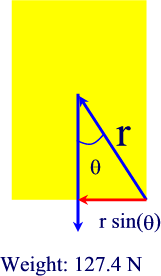
The weight acts at the center of mass, which is the center of the door (we are
told), and so in the diagram above, the arrow straight down is the weight of
the door (127.4 N)
since t =
Frsinq,
and since rsinq
is just half of the width of the door, we don't even need to know r which
would have been the distance from the center of the door to the lower right
hand corner, as it is only the horizontal part of r that matters. (Only
the horizontal location of the center of mass matters). The weight, of
course, exerts an anti clockwise torque about the lower right corner, and acts
at half the width, or 1.3 m / 2 = .65 m, so we have a torque of -(127.4 N)(.65
m) due to the weight.
So our TOTAL TORQUE EQUILIBRIUM looks like:
+(Upperx)(1.90 m) - (Lowerx)(.40 m) -(127.4 N)(.65 m) =
0
Time for math
Here are our equations:
Upperx - Lowerx = 0
Uppery + Lowery - 127.4 N = 0
+(Upperx)(1.90 m) - (Lowerx)(.40 m) -(127.4 N)(.65 m) =
0
Now, we have too many unknowns to be allowed. (4, with only three
equations). I think it is a fair assumption, that if
Upperx - Lowerx = 0, then Upperx = Lowerx
= Hingex (as we will now call it), and then we can assume
that the door is well built, and that the vertical components exerted by the
hinges are identical. (although I have encountered doors in my life
where this is not true :-)
Uppery + Lowery - 127.4 N = 0
So I will assume that Uppery = Lowery = Hingey
(as we will now call it)
So now our equations are more manageable:
Upperx - Lowerx = 0
Uppery + Lowery - 127.4 N = 0
+(Upperx)(1.90 m) - (Lowerx)(.40 m) -(127.4 N)(.65 m) =
0
Becomes
2(Hingey) - 127.4 N = 0
+(Hingex)(1.90 m) - (Hingex)(.40 m) -(127.4 N)(.65 m) =
0
Which makes me smile.
2(Hingey) - 127.4 N = 0, so Hingey = 63.7 N
and
+(Hingex)(1.90 m) - (Hingex)(.40 m) -(127.4 N)(.65 m) =
0
+(Hingex)(1.90 m - .40 m) = 82.81 Nm
Hingex = 55.2 N
So both hinges exert an upward force of 63.7 N (assuming they are mounted in
the right place) and the top hinge exerts a force to the right of 55.2 N, and
the lower hinge exerts a force to the left on the door of 55.2 N
(Table of contents)
20. Calculate the forces F1 and F2 that
the supports exert on the diving board of Fig. 9-48 when a 60-kg person stands
at its tip. Take into account the board's mass of 35kg. Assume the
board's CG is at its center.

Horizontally there is not much going on here, but vertically
we have the two unknown forces F1 and F2, acting
whichever way they act, the weight of the board (35 kg)(9.8 N/kg) = 343
N down (-), and the weight of the diver (60. kg)(9.8 N/kg) = 588 N down (-) so
our force equation looks like:
F1 + F2 - 343
N - 588 N = 0
Torque-wise things are busy. If we use the left side of the board then F1
generates no torque, as it acts at r = 0 from the left side, assuming that F2
is upward, it generates an anti-clockwise (-) torque of (F2)(1.0 m)
as it acts at a distance of 1.0 m from the left side, the weight of the board
acts at its CG, 2.0 m from the left, and so generates a clockwise (+)
torque of (2.0 m)(343 N), and the diver's weight also generates a clockwise
(+) torque, of (4.0 m)(588 N) acting at the very end (4.0 m). Our torque
looks like this:
0 - (F2)(1.0 m) + (2.0 m)(343 N) + (4.0 m)(588 N) = 0
This is directly solvable for F2:
(2.0 m)(343 N) + (4.0 m)(588 N) = (F2)(1.0 m)
F2 = 3038 N = 3.0 x103 N upwards.
And now let's plug into the vertical force equilibrium to solve for F1:
F1 + F2 - 343
N - 588 N = 0
F1 + 3038 N - 343
N - 588 N = 0
F1 = -2107 N = -2.1x103 N (downwards)
(Table of contents)
22. Calculate F1 and F2 for the
beam shown in Fig. 9-56. Assume it is uniform and has a mass of 250kg.
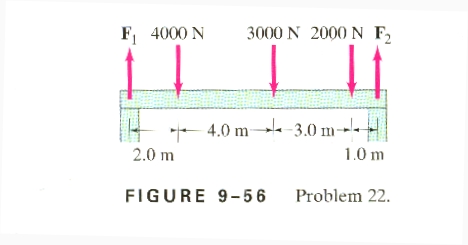
This looks like a force and torque problem. Let's set
up the force equilibrium first. Nothing is happening in the horizontal
direction, but in the vertical direction, we have F1 and F2
up (+) and 4000 N, 3000 N, 2000 N and the weight of the beam (250 kg)(9.8
N/kg) = 2450 N down (-), so our force equilibrium in the vertical direction
looks like:
F1 + F2 - 4000 N - 3000 N - 2000 N - 2450 N = 0
F1 + F2 - 11450 N = 0
But alas, we are not done, as this is two unknowns, but only one
equation. So let's set up the torque equation, about the leftmost side
of the beam, so that the downward forces of 4000 N , 3000 N and 2000N, as well
as the 2450 N weight of the beam (acting in the center) all contribute
clockwise (+) torques, and F1 contributes no torque as it has a
radius of zero, and F2 contributes an anticlockwise (-)
torque. Our torque equilibrium looks like: (t = Frsinq)
F1(0 m) + (4000 N)(2.0 m) + (2450 N)(5.0 m) + (3000 N)(6.0 m) +
(2000 N)(9.0 m) - F2(10.0 m) = 0
F2 = 5625 N
and since from our first equation said that
F1 + F2 - 11450 N = 0
F1 = 11450 N - F2 = 11450 N - 5625 N = 5825 N
(Table of contents)
25. A 170-cm-tall person lies on a light (massless)
board which is supported by two scales, one under the feet and one beneath the
top of the head (Fig. 9-58). The two scales read, respectively, 31.6 and
35.1kg. Where is the center of gravity of this person?
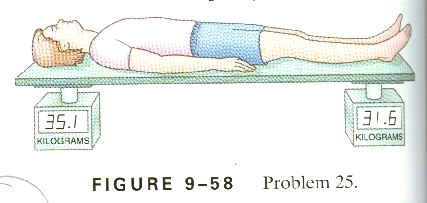
The scales record kilograms, but they are really registering
force, the left one is reading 35.1 kg, which means it is exerting an upward
force of (35.1 kg)(9.8 N/kg) = 343.98 N, and the rightmost one is reading 31.6
kg, which means it is exerting an upward force of (31.6 kg)(9.8 N/kg) = 309.68
N.
Now we need to set up the force equation in the vertical direction. We
have the scales exerting upward forces of 343.98 N and 309.68 N, and gravity
exerting a downward force equal to the weight of the person (the board
is massless), so our vertical equation of equilibrium looks like:
343.98 N + 309.68 N - weight = 0 where weight is the weight of the person.
Lets talk the torque:
Calculating torque from the left side (why not???), the left scale has nothing
to torque about (r = 0) and so the 343.98 N force acts at a distance of 0 from
the left side, and therefore creates no torque. Moving right, we have
the weight of the person generating a clockwise (+) torque, but we don't know
how far over it acts, so we are left with (t = Frsinq)
a torque of +(x)(weight), where x is the distance from the top of the person's
head that their center of mass is. FInally, on the far right side (r =
1.70 m) the rightmost scale exerts an upward force of 309.68 N creating an
anticlockwise torque of -(1.70 m)(309.68 N) = -526.456 Nm. Our Torque
equation looks like:
0 + (x)(weight) -526.456 Nm = 0
MATH time!!!
From the first equation:
343.98 N + 309.68 N - weight = 0
we know that the weight is simply:
343.98 N + 309.68 N = weight = 653.66 N, which we will plug in to our second:
0 + (x)(weight) -526.456 Nm = 0
(x)(653.66 N) = 526.456 Nm
x = 0.805 m from the top of their head, and 1.70 m - 0.805 m = .895 m from
their feet.
(Table of contents)
26. A shop sign weighing 215 N is supported by a uniform
135 N beam as shown in Fig. 9-59. Find the tension in the guy wire and the
horizontal and vertical forces exerted by the hinge on the beam.
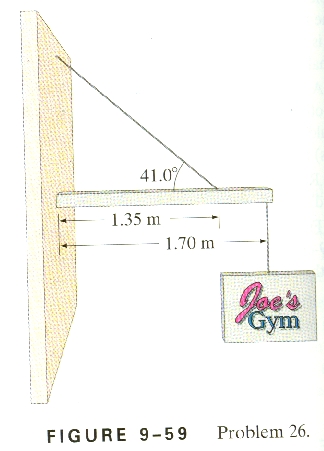
This is a full-sledged torque and two dimensional force
equilibrium problem. Doesn't get too much finer than this. Grade A
USDA all AMERICAN red-blooded, honest to goodness, no nonsense, no joking
around, sure's shootin, God fearin' no-holds barred. OK you get the
point.
Hmm.
Well, let's look at the beam, and start with force. The vertical
direction. The horizontal direction. No, let's start vertically,
not that it much matters much where we start. DOES ANYONE HAVE ANY IDEA
HOW TO SOLVE THIS HERE PROBLEM???
(How 'bout dose Bearss?)
didn't think so.
OK - try to stay calm. Think. In the vertical direction we have
the weight of the sign (215 N) down (-), the weight of the beam (135 N) down
(-), and the wall (Wy) acting umm. HECK IF I KNOW WHICH WAY
THE WALL ACTS IN THE VERTICAL DIRECTION - COULD BE UP, COULD BE DOWN.
guess we'll leave it as a variable. Oh, the tension in the cable has an
upward (+) component Tsin(41.0o), where T is the tension in the
cable. So our vertical expression looks like:
Wy - 215 N - 135 N + Tsin(41.0o) = 0
So. Ho boy. Two unknowns. One equation so far.
Well, horizontally in the force picture we have a component of the cable
tension to the left (-) of Tcos(41.0o), and opposing that to the
right (+) the wall pushing to the right with a force of Wx.
That looks like:
Wx - Tcos(41.0o) = 0
Great. Just great. Another unknown.
Well, on to torque.
From the left side of the beam, (So Wy acts at r = 0) we have the
weight of the beam (135 N) acting at the center (.85 m from the left) of the
beam, and the weight of the sign (215 N) acting at the end (1.70 m) both
creating a clockwise (+) torque, and the vertical component of the tension
(Tsin(41.0o)) acting at 1.35 m from the left creating an anticlockwise (-)
torque:
Wy(0 m) + (135 N)(.85 m) - (Tsin(41.0o))(1.35 m) + (215
N)(1.70 m) = 0
WELL, TORQUE ABOUT EASY!!! - uh that is one equation and one unknown.
0 + 114.75 Nm - (Tsin(41.0o))(1.35 m) + 365.5 Nm = 0
T = 542.24 N = 542 N
WOO HOO!
The rest is easy. Let's just sweep up the pieces. To find the
horizontal component of the force the wall exerts (Wx) we'll use
our second equation:
Wx - Tcos(41.0o) = 0
Wx = (542.24 N)cos(41.0o) = 409 N
And to find the vertical component (Wy) let's use the very first
equation we made:
Wy - 215 N - 135 N + Tsin(41.0o) = 0
Wy = 215 N + 135 N - (542.24 N)sin(41.0o) = -5.74 N - So
it was down after all.
(Table of contents)
27. A traffic light hangs from a structure as shown in
Fig. 9-60. The uniform aluminum pole AB is 7.5m long and has a mass of
8.0kg. The mass of the traffic light is 12.0kg. Determine the
tension in the horizontal massless cable CD, and the vertical and horizontal
components of the force exerted by the pivot A on the aluminum pole.
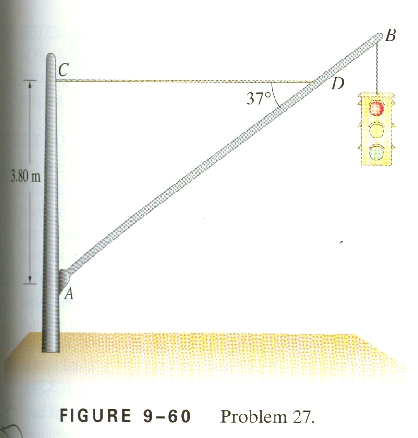
A bit of geometry or trig, the pole is 7.5 m long, but the
cable is attached, hmm sin(37o) = (3.80 m)/hyp, so hyp = (3.80
m)/sin(37o) = 6.314 m from the bottom of the pole.
Force vertical:
Pole weight = (8.0 kg)(9.8 N/kg) = 78.4 N down
Signal weight = (12 kg)(9.8 N/kg) = 117.6 N down
Pivot at pt A = Py
Equilibrium:
Py - 78.4 N - 117.6 N = 0
Force Horizontal:
Cable = T (left)
Pivot at point A = Px (right)
Equilibrium:
Px - T = 0
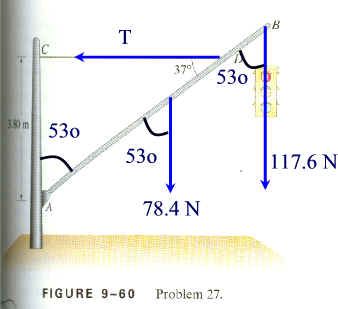
Torque about the bottom point (point A)
The pivot acts at r = 0 so exerts no torque, so that leaves us the weight of
the beam of 78.4 N acting in the middle (at 7.5/2 = 3.75 m from point A), the
tension (T) of the cable acting at 6.314 m from point A, and the weight of the
signal (117.6 N) acting at 7.5 m from point A. Notice that the downward
forces act at a complementary angle (53o) with the angle the
tension makes.
t =
Frsinq,
Pole: +(78.4 N)(3.75 m)sin(53o) (CW)
Signal: +(117.6 N)(7.5 m)sin(53o) (CW)
Cable: -T(6.314 m)
And or course, all this rot adds to zero:
+(78.4 N)(3.75 m)sin(53o) + (117.6 N)(7.5 m)sin(53o) -
T(6.314 m)sin(37o) = 0
234.8 + 704.4 - T(6.314 m)sin(37o) = 0
T = 247.16 N = 250 N
BUT - we're not done. We still need to figure out the force exerted by
the pivot in the vertical and horizontal direction. These two formulas
will help:
Py - 78.4 N - 117.6 N = 0, so
Py = 196 N
Px - T = 0, so
Py= T = 250 N
(Table of contents)
31. Consider again the ladder of Example 9-9 but with a
painter climbing up. If the mass of the ladder is 12.0kg, the mass of the
painter is 60.0kg, and the ladder begins to slip at its base when she is 70
percent of the way up the length of the ladder, what is the coefficient of
static friction between the ladder and the floor? Again assume the wall is
frictionless. A free-body diagram is shown in Fig. 9-63.
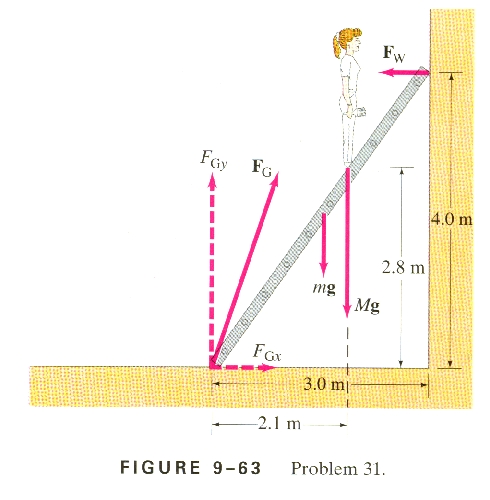
We know at the point of slipping that FGx (See
diagram above) is just equal to the friction force, where the normal force is
FGy (The upward force exerted by the ground on the ladder - see
diagram above.)
So, applying the formula for friction:
Ffr = msFn
(at the point of slipping)
FGx = msFGy
so
ms
= FGx/FGy
So, let's set up our equations.
Vertical Force:
Ladder weight: -(12.0 kg)(9.8 N/kg) = -117.6 N (down)
Person weight: -(60.0 kg)(9.8 N/kg) = -588 N (down)
Ground pushing up: +FGy (up)
Equilibrium:
FGy -117.6 N - 588 N = 0
Horizontal Force:
Force exerted by the wall: -FW (left)
Force exerted by the ground horizontally: +FGx (right)
Equilibrium:
+FGx + -FW = 0
And finally torque:
First, the ladder is at an angle of Tan-1(3/4) = 36.87o
with the wall, the ladder is 5.0 m long, (52 = 32
+ 42), and the person is 3.5 m (70% of 5) from the bottom. We
then have the following torques about the bottom of the ladder:
The ground: torque = 0 (r = 0)
The weight of the ladder: 117.6 N at an angle of 36.87o at a
distance of 5/2 = 2.5 m from the bottom of the ladder. Torque = (2.5 m)(117.6
N)sin(36.87o) = + 176.4 Nm (CW)
The weight of the person on the ladder: 588 N at an angle of
36.87o at a distance of 3.5 m from the bottom of the ladder. Torque
= (3.5 m)(588 N)sin(36.87o) = + 1234.8 Nm (CW)
The wall pushing to the left: FW (an unknown component)
acting at a distance of 5.0 m from the bottom, at an angle of 90o -
36.87o = 53.13o with the ladder. Torque = -(5.0 m)FWsin(53.13o)
(ACW)
Equilibrium:
0 + + 176.4 Nm + 1234.8 Nm - (5.0 m)FWsin(53.13o)
= 0
Which yippee skippee is solvable for FW.
FW = 352.8 N
Using our vertical equation:
+FGx + -FW = 0, it is clear that FGx also is
equal to 352.8 N
And finally, the vertical equation is solvable as well:
FGy -117.6 N - 588 N = 0
FGy = 705.6 N, and finally, to find the friction:
Ffr = msFn
(at the point of slipping)
FGx = msFGy
so
ms
= FGx/FGy =
(352.8 N)/(705.6 N) = .50 - am I
done yet?
(Table of contents)





